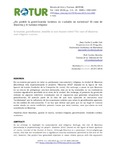Mostrar o rexistro simple do ítem
¿Es posible la gentrificación turística en ciudades no turísticas? El caso de Manresa y el turismo religioso
| dc.contributor.author | Llurdes, Joan Carles | |
| dc.date.accessioned | 2019-03-01T10:32:27Z | |
| dc.date.available | 2019-03-01T10:32:27Z | |
| dc.date.issued | 2018 | |
| dc.identifier.citation | Llurdés Coit, J. C. (2018). ¿Es posible la gentrificación turística en ciudades no turísticas? El caso de Manresa y el turismo religioso. ROTUR. Revista De Ocio Y Turismo, 12(2), 115-134. https://doi.org/10.17979/rotur.2018.12.2.3480 | es_ES |
| dc.identifier.issn | 1888-6884 | |
| dc.identifier.uri | http://hdl.handle.net/2183/22037 | |
| dc.description.abstract | ]Resumen] En un intento por poner en valor su patrimonio monumental y religiosa, la ciudad de Manresa (Barcelona) está implementando el proyecto “Manresa 2022” (basado en la figura de San Ignacio de Loyola, fundador de la Compañía de Jesús). Sin embargo, a pesar de que Manresa es un centro de peregrinaje jesuítico destacado, esto no se ha traducido en un movimiento turístico significativo percibido en el resto de la ciudad. Sin embargo, el proyecto ha generado rechazo en algunos colectivos ciudadanos con el argumento que generará situaciones de gentrificación. El artículo parte de la idea de que esta oposición se encuentra muy “mediatizada” por la influencia de las numerosas noticias que sobre la gentrificación aparecen en los medios de comunicación. Y no hay que olvidar que para que en un lugar el turismo acabe siendo un sector conflictivo, primero tienen que venir turistas, cosa que ahora no está sucediendo en Manresa | es_ES |
| dc.description.abstract | [Abstract] In an attempt to highlight its monumental and religious heritage, the city of Manresa (Barcelona) is implementing the project "Manresa 2022" (based on the figure of Saint Ignatius of Loyola, founder of the Society of Jesus). Although Manresa is a prominent Jesuit pilgrimage center, this has not translated into a significant tourism movement perceived in the rest of the city, however, the project has generated rejection in some citizen groups with the argument that it will generate situations of gentrification The paper starts from the idea that this opposition is very "mediated" by the influence of the numerous news about gentrification that appear in the media, and we must not forget that in order for tourism to end up being a conflictive sector, tourists must first come, but that is not happening in Manresa now. | es_ES |
| dc.language.iso | spa | es_ES |
| dc.publisher | Universidade da Coruña | es_ES |
| dc.relation.uri | https://doi.org/10.17979/rotur.2018.12.2.3480 | |
| dc.rights | Atribución-CompartirIgual 4.0 España | es_ES |
| dc.rights.uri | http://creativecommons.org/licenses/by-sa/4.0/es/ | * |
| dc.subject | Manresa | es_ES |
| dc.subject | Ignacio de Loyola | es_ES |
| dc.subject | Turismo religioso | es_ES |
| dc.subject | Gentrificación | es_ES |
| dc.subject | Ciudades medias | es_ES |
| dc.subject | Mediático | es_ES |
| dc.subject | Ignatius of Loyola | es_ES |
| dc.subject | Religious tourism | es_ES |
| dc.subject | Gentrification | es_ES |
| dc.subject | Medium cities | es_ES |
| dc.subject | Media communication | es_ES |
| dc.title | ¿Es posible la gentrificación turística en ciudades no turísticas? El caso de Manresa y el turismo religioso | es_ES |
| dc.title.alternative | Is tourism gentrification possible in non-tourist cities? The case of Manresa and religious tourism | es_ES |
| dc.type | info:eu-repo/semantics/article | es_ES |
| dc.rights.access | info:eu-repo/semantics/openAccess | es_ES |
| UDC.journalTitle | ROTUR. Revista de ocio y turismo | es_ES |
| UDC.volume | 12 | es_ES |
| UDC.issue | 2 | es_ES |
| UDC.startPage | 115 | es_ES |
| UDC.endPage | 134 | es_ES |
| dc.identifier.doi | https://doi.org/10.17979/rotur.2018.12.2.3480 |






